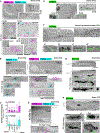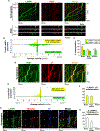Post-Golgi carriers, not lysosomes, confer lysosomal properties to pre-degradative organelles in normal and dystrophic axons
- PMID: 33910020
- PMCID: PMC8135226
- DOI: 10.1016/j.celrep.2021.109034
Post-Golgi carriers, not lysosomes, confer lysosomal properties to pre-degradative organelles in normal and dystrophic axons
Abstract
Lysosomal trafficking and maturation in neurons remain poorly understood and are unstudied in vivo despite high disease relevance. We generated neuron-specific transgenic mice to track vesicular CTSD acquisition, acidification, and traffic within the autophagic-lysosomal pathway in vivo, revealing that mature lysosomes are restricted from axons. Moreover, TGN-derived transport carriers (TCs), not lysosomes, supply lysosomal components to axonal organelles. Ultrastructurally distinctive TCs containing TGN and lysosomal markers enter axons, engaging autophagic vacuoles and late endosomes. This process is markedly upregulated in dystrophic axons of Alzheimer models. In cultured neurons, most axonal LAMP1 vesicles are weakly acidic TCs that shuttle lysosomal components bidirectionally, conferring limited degradative capability to retrograde organelles before they mature fully to lysosomes within perikarya. The minor LAMP1 subpopulation attaining robust acidification are retrograde Rab7+ endosomes/amphisomes, not lysosomes. Restricted lysosome entry into axons explains the unique lysosome distribution in neurons and their vulnerability toward neuritic dystrophy in disease.
Keywords: LAMP1; acidification; autophagic vacuole; axonal transport; late endosome; lysosome; post-Golgi traffic; transport carrier.
Copyright © 2021 The Author(s). Published by Elsevier Inc. All rights reserved.
Conflict of interest statement
Declaration of interests The authors declare no competing interests.
Figures







Similar articles
-
Lysosomal proteolysis inhibition selectively disrupts axonal transport of degradative organelles and causes an Alzheimer's-like axonal dystrophy.J Neurosci. 2011 May 25;31(21):7817-30. doi: 10.1523/JNEUROSCI.6412-10.2011. J Neurosci. 2011. PMID: 21613495 Free PMC article.
-
Impaired axonal retrograde trafficking of the retromer complex augments lysosomal deficits in Alzheimer's disease neurons.Hum Mol Genet. 2017 Nov 15;26(22):4352-4366. doi: 10.1093/hmg/ddx321. Hum Mol Genet. 2017. PMID: 28973312 Free PMC article.
-
The secret life of degradative lysosomes in axons: delivery from the soma, enzymatic activity, and local autophagic clearance.Autophagy. 2020 Jan;16(1):167-168. doi: 10.1080/15548627.2019.1669869. Epub 2019 Sep 23. Autophagy. 2020. PMID: 31533518 Free PMC article. Review.
-
Revisiting LAMP1 as a marker for degradative autophagy-lysosomal organelles in the nervous system.Autophagy. 2018;14(8):1472-1474. doi: 10.1080/15548627.2018.1482147. Epub 2018 Jul 23. Autophagy. 2018. PMID: 29940787 Free PMC article.
-
Transport-dependent maturation of organelles in neurons.Curr Opin Cell Biol. 2022 Oct;78:102121. doi: 10.1016/j.ceb.2022.102121. Epub 2022 Aug 26. Curr Opin Cell Biol. 2022. PMID: 36030563 Review.
Cited by
-
Axonal Transport of Lysosomes Is Unaffected in Glucocerebrosidase-Inhibited iPSC-Derived Forebrain Neurons.eNeuro. 2023 Oct 10;10(10):ENEURO.0079-23.2023. doi: 10.1523/ENEURO.0079-23.2023. Print 2023 Oct. eNeuro. 2023. PMID: 37816595 Free PMC article.
-
Gut Microbiome Regulation of Autophagic Flux and Neurodegenerative Disease Risks.Front Microbiol. 2021 Dec 23;12:817433. doi: 10.3389/fmicb.2021.817433. eCollection 2021. Front Microbiol. 2021. PMID: 35003048 Free PMC article. Review.
-
mTOR inhibition in Q175 Huntington's disease model mice facilitates neuronal autophagy and mutant huntingtin clearance.Elife. 2025 May 20;14:RP104979. doi: 10.7554/eLife.104979. Elife. 2025. PMID: 40392702 Free PMC article.
-
Synaptic Vesicle Recycling and the Endolysosomal System: A Reappraisal of Form and Function.Front Synaptic Neurosci. 2022 Feb 25;14:826098. doi: 10.3389/fnsyn.2022.826098. eCollection 2022. Front Synaptic Neurosci. 2022. PMID: 35280702 Free PMC article. Review.
-
The needs of a synapse-How local organelles serve synaptic proteostasis.EMBO J. 2022 Apr 4;41(7):e110057. doi: 10.15252/embj.2021110057. Epub 2022 Mar 14. EMBO J. 2022. PMID: 35285533 Free PMC article. Review.
References
-
- Abeliovich A, and Gitler AD (2016). Defects in trafficking bridge Parkinson’s disease pathology and genetics. Nature 539, 207–216. - PubMed
-
- Andrä K, Abramowski D, Duke M, Probst A, Wiederhold KH, Bürki K, Goedert M, Sommer B, and Staufenbiel M. (1996). Expression of APP in transgenic mice: a comparison of neuron-specific promoters. Neurobiol. Aging 17, 183–190. - PubMed
-
- Authier F, Posner BI, and Bergeron JJ (1996). Endosomal proteolysis of internalized proteins. FEBS Lett. 389, 55–60. - PubMed
Publication types
MeSH terms
Grants and funding
LinkOut - more resources
Full Text Sources
Other Literature Sources
Molecular Biology Databases
Research Materials
Miscellaneous

